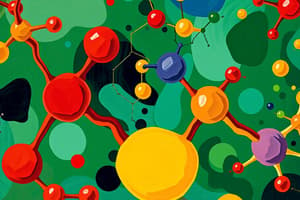Podcast
Questions and Answers
What elements always compose lipids?
What elements always compose lipids?
Carbon, Hydrogen, Oxygen, and sometimes Phosphorus.
What are the four types of lipids?
What are the four types of lipids?
Triglycerides, phospholipids, waxes, and steroids.
Which lipid is generally referred to as fat?
Which lipid is generally referred to as fat?
Triglycerides
How would you differentiate a carbohydrate from a triglyceride based on its structure?
How would you differentiate a carbohydrate from a triglyceride based on its structure?
What are the basic structural characteristics of all fatty acids?
What are the basic structural characteristics of all fatty acids?
What does an acid group look like?
What does an acid group look like?
How is it possible that there are different fatty acids?
How is it possible that there are different fatty acids?
What is the basic structure of a triglyceride?
What is the basic structure of a triglyceride?
What are two major classifications of fats?
What are two major classifications of fats?
How many double bonds between carbons do saturated fats have?
How many double bonds between carbons do saturated fats have?
How many double bonds between carbons do unsaturated fats have?
How many double bonds between carbons do unsaturated fats have?
Unsaturated fats can be either _____ or _____ -unsaturated.
Unsaturated fats can be either _____ or _____ -unsaturated.
If a fat is saturated, it has no double bonds. What element are the carbon's other bonds with?
If a fat is saturated, it has no double bonds. What element are the carbon's other bonds with?
If there is a double bond between carbons, there are fewer bonds between carbon and hydrogen.
If there is a double bond between carbons, there are fewer bonds between carbon and hydrogen.
How does being either saturated or unsaturated affect the physical structure of a fat?
How does being either saturated or unsaturated affect the physical structure of a fat?
What is the name of the process that adds hydrogens to an unsaturated fat?
What is the name of the process that adds hydrogens to an unsaturated fat?
What happens to the physical state of a lipid once it is hydrogenated?
What happens to the physical state of a lipid once it is hydrogenated?
What is the function of a triglyceride in your body?
What is the function of a triglyceride in your body?
What is the function of a phospholipid in your body?
What is the function of a phospholipid in your body?
What are the functions of cholesterol?
What are the functions of cholesterol?
What are the functions of wax?
What are the functions of wax?
What is the name of the process that adds a double bond to a saturated fat?
What is the name of the process that adds a double bond to a saturated fat?
What happens to the physical state of a lipid once it is dehydrogenated?
What happens to the physical state of a lipid once it is dehydrogenated?
What are fats found in your kitchen that have saturated fatty acid chains?
What are fats found in your kitchen that have saturated fatty acid chains?
What are fats found in your kitchen that have poly/unsaturated fatty acid chains?
What are fats found in your kitchen that have poly/unsaturated fatty acid chains?
The hydrolysis of fat produces what?
The hydrolysis of fat produces what?
What is the key chemical difference between a phospholipid and a triglyceride?
What is the key chemical difference between a phospholipid and a triglyceride?
What is a saturated lipid?
What is a saturated lipid?
What is an unsaturated lipid?
What is an unsaturated lipid?
Flashcards are hidden until you start studying
Study Notes
Lipids Overview
- Lipids consist of Carbon, Hydrogen, and Oxygen (CHOP), with Phosphorus sometimes included.
- Four main types of lipids: triglycerides, phospholipids, waxes, and steroids.
Triglycerides
- Commonly referred to as fats.
- Composed of glycerol and three fatty acid chains.
- Used for long-term energy storage in the body.
Fatty Acids
- Basic structure includes long carbon chains with an acid group.
- Differentiated by the types of bonds (single, double) between carbon atoms.
- Saturated fats have no double bonds (0); unsaturated fats have at least one double bond (1+).
- Unsaturated fats can be classified as mono-unsaturated (one double bond) or polyunsaturated (multiple double bonds).
Saturated vs. Unsaturated Fats
- Saturated fats are solid at room temperature, while unsaturated fats are typically liquid.
- Double bonds in unsaturated fats create kinks in the fatty acid chains, preventing tight packing.
- Hydrogenation adds hydrogen to unsaturated fats, converting them to solid forms.
- Dehydrogenation adds double bonds to saturated fats, potentially making them liquid.
Phospholipids
- Major component of cell membranes.
- Distinct from triglycerides by the presence of phosphorus.
Cholesterol
- Functions include hormone production, Vitamin D synthesis, regulation of body functions, and structural support for cells.
Waxes
- Provide protection for the body and insulate plant leaves, preventing desiccation.
Kitchen Fats
- Common saturated fats include butter and bacon, which contain saturated fatty acid chains.
- Common polyunsaturated fats include corn oil and olive oil.
Hydrolysis of Fats
- The process produces three fatty acids and a glycerol backbone.
Chemical Properties
- Saturated lipids are generally solid at room temperature and contain no double bonds between carbon atoms, making them less healthy.
- Unsaturated lipids contain at least one carbon-carbon double bond and are often liquids.
Studying That Suits You
Use AI to generate personalized quizzes and flashcards to suit your learning preferences.




